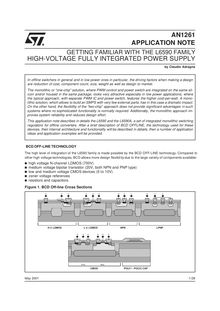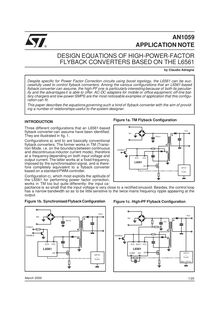Auteur
Claudio Adragna
Œuvres

Documents
BCD OFF LINE TECHNOLOGY The high level of integration of the L6590 family is made possible by the BCD OFF LINE technology Compared to other high voltage technologies BCD allows more design flexibil ity due to the large variety of components available: n high voltage N channel LDMOS 700V n medium voltage bipolar transistor 20V both NPN and PNP type n low and medium voltage CMOS devices to 10V n zener voltage references n resistors and capacitors Figure BCD Off line Cross Sections
Claudio Adragna

Documents
Collège - Lycée
BCD OFF LINE TECHNOLOGY The high level of integration of the L6590 family is made possible by the BCD OFF LINE technology Compared to other high voltage technologies BCD allows more design flexibil ity due to the large variety of components available: n high voltage N channel LDMOS 700V n medium voltage bipolar transistor 20V both NPN and PNP type n low and medium voltage CMOS devices to 10V n zener voltage references n resistors and capacitors Figure BCD Off line Cross Sections
Claudio Adragna
28 pages
English

Documents
INTRODUCTION Three different configurations that an L6561 based flyback converter can assume have been identified They are illustrated in fig Configurations a and b are basically conventional flyback converters The former works in TM Transi tion Mode i e on the boundarybetween continuous and discontinuous inductor current mode therefore at a frequency depending on both input voltage and output current The latter works at a fixed frequency imposed by the synchronisation signal and is there fore completely equivalent to a flyback converter based on a standard PWM controller Configuration c which most exploits the aptitude of the L6561 for performing power factor correction works in TM too but quite differently: the input ca pacitance is so small that the input voltage is very close to a rectified sinusoid Besides the control loop has a narrow bandwidth so as to be little sensitive to the twice mains frequency ripple appearing at the output
Claudio Adragna

Documents
Corrigés de devoir
INTRODUCTION Three different configurations that an L6561 based flyback converter can assume have been identified They are illustrated in fig Configurations a and b are basically conventional flyback converters The former works in TM Transi tion Mode i e on the boundarybetween continuous and discontinuous inductor current mode therefore at a frequency depending on both input voltage and output current The latter works at a fixed frequency imposed by the synchronisation signal and is there fore completely equivalent to a flyback converter based on a standard PWM controller Configuration c which most exploits the aptitude of the L6561 for performing power factor correction works in TM too but quite differently: the input ca pacitance is so small that the input voltage is very close to a rectified sinusoid Besides the control loop has a narrow bandwidth so as to be little sensitive to the twice mains frequency ripple appearing at the output
Claudio Adragna
20 pages
English